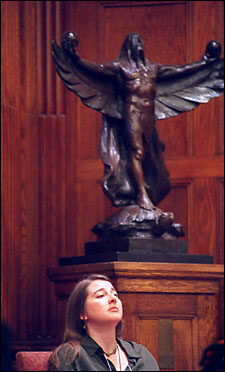350th anniversary of Indian College commemorated
Dedicated to the ‘education of … English and Indian youth’

Those who take for granted that Harvard University is located in Cambridge, Mass., had an opportunity over the past weekend to think differently: From the Indian perspective, Harvard is really situated in the heart of Wampanoag country, where the inhabitants had lived for 10,000 years before English settlers arrived to build a “new world,” and “to Christianize the heathen.”
A commitment to “the education of the English and Indian youth of the country” was part of the Harvard Charter of 1650, and in 1655, the Harvard Indian College was founded.
That founding was commemorated this past April 8 and 9 with a conference called “From the Gospel to Sovereignty: Commemorating 350 Years of the Harvard Indian College,” sponsored by the Harvard University Committee on Ethnic Studies and the Harvard University Native American Program (HUNAP). That early commitment to Indian education – a seed planted centuries ago – has borne significant fruit only in recent decades.
The conference was an effort to “reclaim our Harvard history,” as executive director of HUNAP Carmen Lopez put it in her welcoming remarks in the Barker Center for the Humanities. “Let us invoke ‘veritas’ today,” she urged; “let us indigenize ‘veritas.’”

Lopez, a Navajo from Black Mesa, Ariz., and Farmington, N.M., began by acknowledging the presence of leaders of the indigenous Wampanoag Tribe of Gay Head Aquinnah, the Mashpee Wampanoag Tribe, and the Nipmuc Nation, and thanking them for letting her speak. “Right now we will make a native space here in this room,” she said.
Converting the natives to Christianity was a major goal of the early English colonists. And, as history lecturer Lisa Brooks explained in her remarks, when Harvard got into financial difficulties in its early years and needed funds to keep from foundering, college officials found that the missionary goal was not only, to their thinking, a noble one, but also one that donors were willing to support.
And, thus, the Harvard Indian College was founded. It was housed in the first brick building in the Yard, which until that point had included only wooden buildings. The structure, on the site where Matthews Hall stands today, was paid for by an English charitable foundation, the Society for the Propagation of the Gospel in New England. It eventually housed the college printing press, which produced the first Bible printed in North America, an edition of the Scriptures in the Algonquian language.
A goal of the college, where English and Indian students were housed together, was language exchange; the English sought to learn Algonquian well enough to preach to the natives, and the Wampanoag, scholars today surmise, wanted to learn the white man’s language well enough to negotiate with the newcomers, whose arrival, Brooks noted, the Indians referred to as “the time the world turned upside down.”
Although the college attracted students of promise, only one graduated in the 17th century, Caleb Cheeshahteaumuck. He died of tuberculosis at age 20. The lives of several other Indian students ended tragically early as well. Not until well into the 20th century did Harvard produce its next Indian graduate. In 1970, the American Indian Program was established on campus to train Native American leaders. The 11 Indian students enrolled in the master’s degree program of the Graduate School of Education at that time represented the greatest number of Indians on campus since the middle of the 17th century.
In the intervening years, more than 800 Indians have earned Harvard degrees, and today there are more than 120 Indians on campus. At the April 8 conference opening, four of them spoke on their experiences as Harvard undergraduates: April Youpee ’08, Leah Lussier ’07, Erica Scott ’06, and Kyle Scherer ’05.
Patrik Johansson, a Cherokee on the faculty of the Harvard School of Public Health, spoke of the 350th anniversary of the Indian College as an occasion for reinterpreting the commitment to Indian education, as “an opportunity to revisit what this means.”
In 1654, he recounted, the colonists of New Sweden, which was eventually incorporated into New Jersey, Pennsylvania, Delaware, and Maryland, signed a mutual assistance pact with the Lenni Lenape tribe. The Swedes soon lost out to the Dutch, and eventually withdrew from the New World. But just last year, the Swedish ambassador, Jan Eliasson, visited the tribe to reaffirm the friendship and seek ways to continue a relationship.
That relationship may be a model, Johansson suggested, for addressing the complicated mixed legacy of the relationship between American Indians and Harvard.




